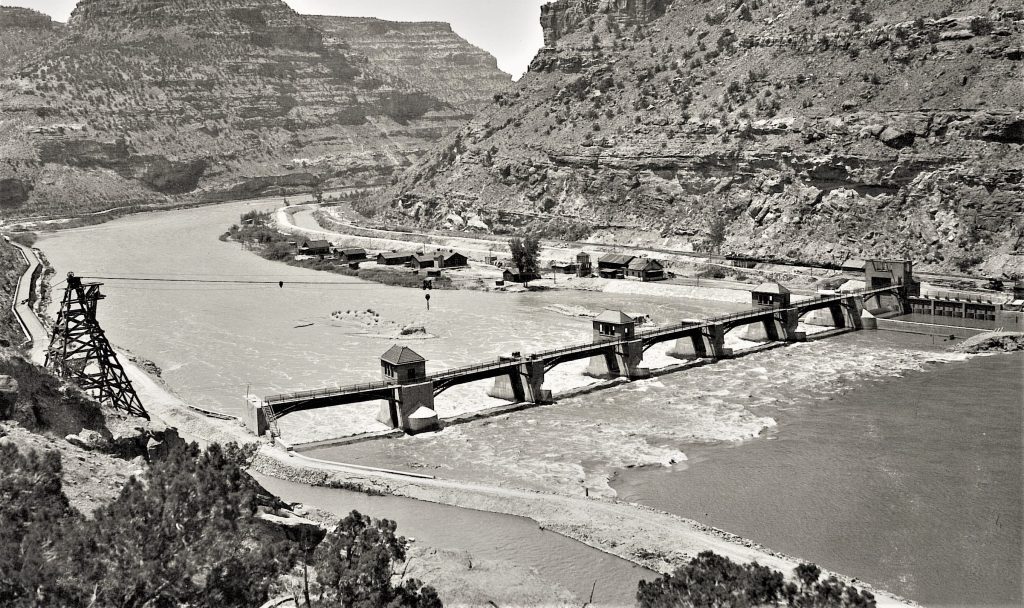1147 24 Road, Grand Junction, CO • Open Monday-Friday 7:30am-4pm
Irrigation Provider Search
Grand Valley Water Users Association
Irrigation Provider Search
About GVWUA
A Brief History of Grand Valley Water Users Association
National Reclamation Act of 1902
Water would be essential for the development of the arid American West. The United States Congress passed the Reclamation Act in 1902 to build infrastructure for irrigation water and hydropower. The Reclamation Service (later renamed Bureau of Reclamation) partnered with local organizations in western states and territories to complete these waterworks. The projects were funded through the sale of federal land in western states and repayment of project costs by the beneficiaries.
Grand Valley Water Users Association
In 1905, Colorado’s General Assembly authorized the formation of local water associations to enter into repayment agreements with the Reclamation Service for construction of irrigation infrastructure. That same year, Grand Valley Water Users Association (GVWUA) was organized as a private Colorado not-for-profit corporation and it remains so today.
Grand Valley Project
GVWUA and the Reclamation Service developed the Grand Valley Project. This federal project irrigates the higher ground north of the Colorado River in the Grand Valley of Mesa County, Colorado. GVWUA has operated the Grand Valley Project since its completion and repaid the cost of its construction.
Grand Valley Project Facilities
- Grand Valley Diversion Dam – aka the Roller Dam – on the Colorado River in DeBeque Canyon
- Government Highline Canal, which is 55 miles long
- 130 miles of laterals
- More than 100 miles of drains
- Partnership in a hydroelectric power plant
In recent years, nearly all of the laterals have been reconstructed as pressure-piped laterals. They deliver irrigation water to more than 1,000 individual locations. Much of the Government Highline Canal is lined to prevent seepage and to reduce salinity and selenium loading in the Colorado River.
Irrigation Water Delivery
GVWUA diverts water at the Roller Dam on the main stem of the Colorado River east of Palisade, Colorado in DeBeque Canyon. This water is delivered to:
- Orchard Mesa Irrigation District
- Mesa County Irrigation District
- Palisade Irrigation District
- Vinelands Power Plant
- Grand Valley Water Users
The five-mile Canyon Canal portion of the Government Highline Canal travels through three tunnels before entering the Grand Valley northeast of the town of Palisade.
Before entering Tunnel Three, the water for the Orchard Mesa Irrigation District and the Vinelands Power Plant is directed under the Colorado River and Interstate 70 into the facilities of the Orchard Mesa Irrigation District.
At the outfall of Tunnel Three, GVWUA diverts water from the Canal into the Stub Ditch for the Mesa County Irrigation District and the Price Ditch for the Palisade Irrigation District. GVWUA also provides water to both Districts through Main Canal Headgates on the Canal between Tunnel Three and Indian Wash east of 28 Road.
Delivery of irrigation water to GVWUA water users begins on the west side of Indian Wash near 28 1/2 Road and continues westward, ending near 5 Road.
The Government Highline Canal provides irrigation water to approximately 25,000 acres in the GVWUA service area and approximately 15,000 acres in the other irrigation districts listed above.
Links to Learn More
- Rocky Mountain PBS Colorado Experience: Western Water – and Power
Colorado Experience: Western Water—and Power – YouTube
- Palisade Historical Society: Irrigation History
Irrigation History | Palisade Historical Society (historicpalisade.org)
- The Bureau of Reclamation: A Very Brief History
Bureau of Reclamation (usbr.gov)
- Grand Valley Project
Grand Valley Project (usbr.gov)
GRAND VALLEY PROJ. D2 (usbr.gov)

Roller Dam in June 1916
Responsibilites of GVWUA
Who We Are
Grand Valley Water Users is tasked with maintaining and conserving our easements.
Irrigation canals and ditches and associated banks, roadways, gates, and irrigation facilities are private property not open for use by the public for any purpose without consent of the affected landowners and Grand Valley Water Users. Please respect that many of these easements are on land owned by families whose property the easement crosses. It’s not public property. We respect the privacy of the people whose property our easement crosses and ask you do the same. The easements that are title owned by the Bureau of Reclamation are no different. It’s still private property—not authorized for public use.
Unauthorized entry on private property is legally considered trespass. This includes all trespass—whether for walking a dog, riding a bike, dumping of trash or debris, or camping.
GVWUA maintains our easements to assure reliable delivery of irrigation water to our users. We take pride in keeping our easements well-kept and free of encroachments.
Canals can be dangerous and they are not patrolled! Don’t risk the safety of yourself or others by trespassing on our easement!
The canal roads are not monitored! Should something happen while on our easement, it could take valuable time for authorities to find you to administer aid.
Due to continued disregard for our posted signs and gates, GVWUA will begin taking legal action against trespass.
What We Do
GVWUA is responsible for the flow of water in its canal, in its laterals and through its headgates.
All parts of delivery systems (ditches, laterals, pipelines, pumps) beyond the headgates are the responsibility of landowners.
Easements and Rights-of-Way Explained
Who owns them, who has rights to them, and how do they work? Click the link below for an in-depth look at the different easements and how they may affect you as a property owner.
